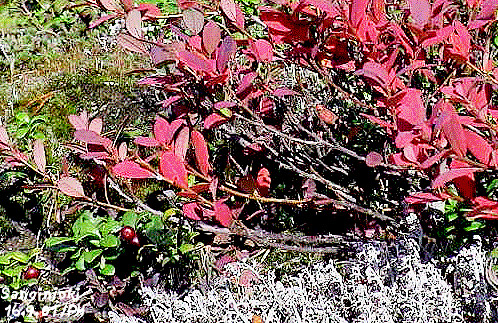

Kuvia pohjoisesta luonnosta
Photos from northern nature
(vuosi/year 2001)
Muihin valintoihin pääset palaamalla takaisin (käytä selaimen Back-painiketta)!
(Tai myös tästä!)
To picture-selecting and other menus: go back using the back-button of the browser!
(Or click here!)

Syksy on ollut poikkeuksellisen lämmin, mutta ruska on nyt Lapissa parhaimmillaan syyskuun puolivälissä
ja saavuttaa näinä päivinä Oulun leveysasteen.
Lämpötila ei tätä prosessia ohjaa niikään,
vaan ennen kaikkea päivänpituus (päivän lyheneminen).
Koivun lehdissä on tänäkin syksynä ruostetta,
mutta sillä ei ole mitään tekemistä ruskan kanssa (vrt koivunlehtiruoste!).
Kuvassa kauniinpunaisia juolukan (Vaccinium uliginosum) lehtiä ja muutama
kypsä puolukan (V. vitis-idaea) marja... Foto: 16.9.01/PH.
It has been an unseasonable warm autumn, but autumn colors are on view in Lapland reaching already in Oulu.
Shortening of days is the most important effect to this, not the temperature.
Also in this autumn the blight of birch has been common in northern Finland.
This has nothing to do with autumn colors (see the blight of birch!).
In this picture red leaves of bog bilberry (Vaccinium uliginosum) and
some mature berries of lingonberry (V. vitis-idaea). Foto: 16.9.01/PH.

Vaikka kuluva syksy onkin ollut lämmin, ovat maa ja kasvit nyt lokakuun lopulla huurteessa
ainakin aamuisin. Puolukka ja karhunsammal sinnittelevät yli talven vihreinä,
mutta esim. mustikka (kuvan oikea yläkulma) on jo karistanut melkein kaikki lehtensä.
Tällaisessa varjoisassa metsässä mustikka ei juurikaan saa ruskaväritystä,
vaan lehtivihreän ainesosien (lähinnä typpiyhdisteiden) siirryttyä varteen, lehdet kellastuvat,
ja varsi pysyy vihreänä. Mustikka aloittaa varsillaan aika tehokkaan keväisen
yhteyttämistyönsä jo lumessa, ennen lehtien puhkeamista.
It has been a rather warm autumn, but now, at the end of October, the soil and plants
are hoar-frosted at least in the morning. The lingonberry and
most of mosses (Polytrichum in the picture) keep green colours over the winter,
but e.g. the bilberry (on the right corner of picture) has sheded nearly all leaves.
In the shady forest like this the leaves of bilberry will not get the autumncolors,
but the leaves turn lighter after the components of chlorophyll has been transfered
to the stems. Bilberry will start to assimilate with the green stems in spring already
in the snow before the leaves be born.



